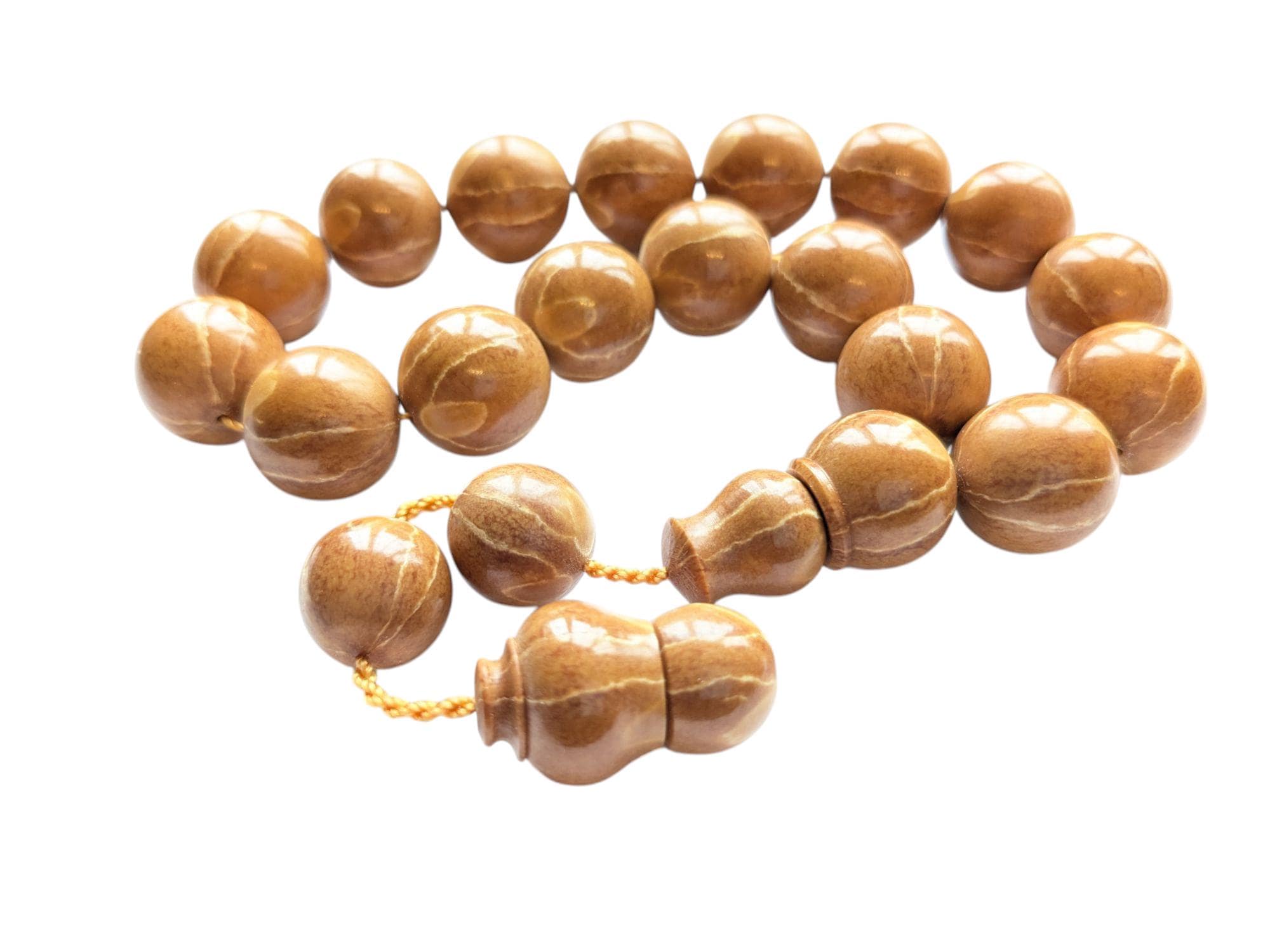🌳 Wooden Beads
Popular Types: Olive wood, snake wood, buckthorn, wenge, agarwood, sandalwood, rosewood, ebony, boxwood
Used in: Tesbih, Tasbih, Komboloi, Misbaha, Subha
Why It’s Popular:
- Traditional and natural, wood is widely available and historically used across the Mediterranean and Middle East.
- Lightweight and warm to the touch, offering a soothing feel.
- Grounding and adding sensory appeal.
- Being Lightweight makes the thread / cord lifespan longer.
- Variety of Wood including Exotic with different properties
- Usually fully handmade making it a collector's item
Advantages:
- Widely available.
- Lightweight – ideal for everyday carry.
- Soft clicking sound – discreet and calming.
- Can get a darker colour tone or develop a beautiful patina over time.
Disadvantages:
- Susceptible to water, oil, or sun damage.
- May wear down faster under constant use.
- May have natural imperfections due to natural wood
💎 Gemstone Beads
Popular Types: Agate, onyx, turquoise, jade, carnelian Used in: Tesbih, Tasbih, Komboloi, Misbaha, Subha
Why It’s Popular:
- Each stone carries symbolic or healing properties, making them meaningful and personal.
- Rich colors and natural patterns give every bead a unique look.
Advantages:
- Durable and long-lasting.
- Visually striking – excellent for gifting or display.
- Heavier feel – often preferred for meditative rhythm.
- Cool to the touch – calming sensory experience.
Disadvantages:
- Heavier – not everyone prefers the weight.
- Cord needs to be changed more frequently compared to wood due to weight.
- Can chip or crack if dropped.
🧪 Amberoid (Faturan/Bakelite Style)
Popular Types: amberoid, amberoid rods, faturan, bakelite, new faturan, new bakelite, SIKMA, SIKMA Kehribar, Ates Kehribar, Cubuk Malzeme
What It Is:
Amberoid is a man-made resin developed in the early 20th century as a substitute for amber, often referred to as Faturan or antique bakelite in Turkish tesbih culture.
Why It’s Popular:
- Became highly valued in Ottoman times, especially among collectors and “tesbih ustaları” (tasbih masters).
- Known for its unique click, smell, and ageing effect (changes colour with time and use).
- Some old amberoid beads are considered antiques and can be very expensive. Tasbih museums are full of beautiful amberoid and faturan tasbih examples.
Advantages:
- Excellent tactile feel – smooth and satisfying click.
- Durable and resistant to cracking.
- Highly collectible, especially vintage types.
- Holds warmth and can develop a beautiful aged patina.
Disadvantages:
- More expensive if antique or handmade.
- Synthetic – not preferred by those who favour natural materials.
- Can be affected by high heat or chemicals.
🐐 Natural Animal-Derived Materials (Bone & Horn)
Popular Types: Camel bone, buffalo horn, ram horn
Used in: Tesbih, Tasbih, Komboloi, Misbaha, Subha
Why It’s Popular:
- These materials have been used for centuries in combs, hilts, and beads.
- Known for their durability and unique textures.
- Often associated with strength, heritage, and masculinity.
Advantages:
- Distinct look and feel — warm, dense, and tactile.
- Durable and resistant to cracking under normal use.
- Aged bone and horn can develop beautiful tones and polish.
Disadvantages:
- Slightly heavier than wood, but lighter than stone.
- Requires ethical sourcing — not suitable for all preferences.
🧿 Final Thoughts
- Choose wood for a lightweight, traditional feel.
- Opt for gemstones for energy, colour, and symbolism.
- Select amberoid/faturan for a luxurious, vintage-inspired experience.
- Try bone or horn for earthy elegance, tactile richness, and cultural heritage.
At DunyaGems, we celebrate the diversity of these materials in our handcrafted komboloi and tesbih collections. Whether you prefer the rustic grain of olive wood or the deep warmth of buffalo horn, there’s a piece that’s just right for your hands — and your story.

